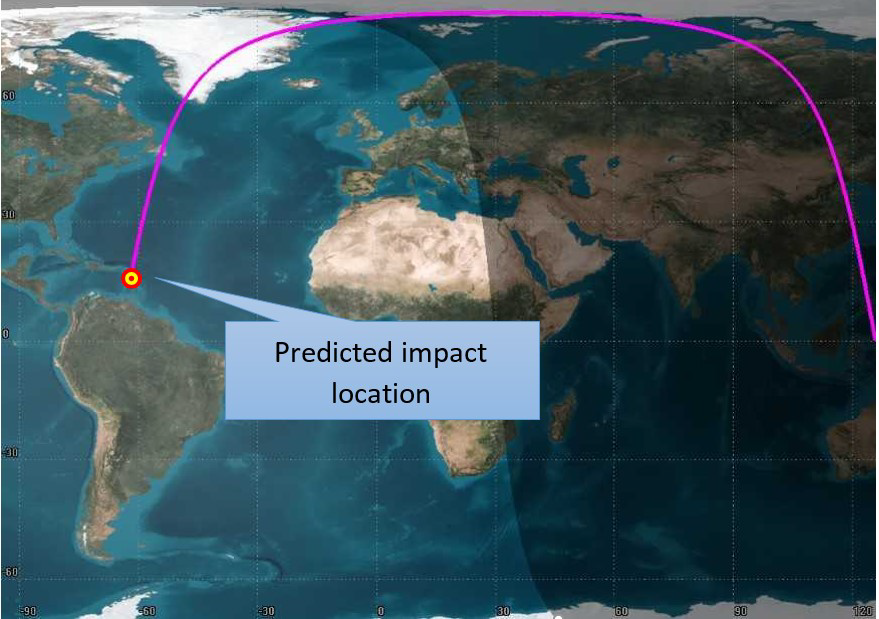PSLV-37 (Prelims- Science & Technology)
Why in News?
The upper stage of PSLV-37 which launched a record number of 104 satellites re-enters the Earth’s atmosphere on 6 Oct 2024.

PSLV-C37 was launched on 15 Feb 2017 with Cartosat-2D as the main payload. It created history as the first mission to launch 104 satellites with a single-vehicle.
After injecting the satellites and passivation, the upper stage (PS4) was left at an orbit of approximately 470x 494 km size. It was regularly tracked by USSPACECOM.
Since September 2024, IS4OM (ISRO System for Safe and Sustainable Space Operations Management) regularly monitored the orbital decay as part of its regular activities and predicted the re-entry into the atmosphere in the first week of October 2024.
As per US Space Command (USSPACECOM) prediction published in Space Track, the re-entry took place on 06 Oct 2024 15:49 UTC (+/-1 minute of uncertainty), while IS4OM prediction also showed that the re-entry would occur on 06 Oct 2024 at 15:48:25 UTC. The corresponding impact point is in the North Atlantic Ocean.
The atmospheric re-entry of the rocket body within 8 years of its launch is fully compliant with the international debris mitigation guidelines, in particular, the guideline of Inter-Agency Space Debris Coordination Committee (IADC) that recommends limiting the post-mission orbital life of a defunct object in Low-Earth orbit (LEO) to 25 years.
As part of its longstanding commitment to preserve long term sustainability of outer space activities, ISRO will continue to implement proactive measures to meet the objectives of Debris Free Space Mission (DFSM) by the year 2030.
Space debris is any non-functional object humans leave in space. It can come from rocket-launching material and defunct satellites or from metal, screws, paint flakes, and other smaller items there is no standard legal framework to regulate space traffic and mitigate space debris.
| The Inter-Agency Space Debris Coordination Committee (IADC)The Inter-Agency Space Debris Coordination Committee (IADC) is an international governmental forum for the worldwide coordination of activities related to the issues of man-made and natural debris in space.The primary purposes of the IADC are to exchange information on space debris research activities between member space agencies, to facilitate opportunities for cooperation in space debris research, to review the progress of ongoing cooperative activities, and to identify debris mitigation options. The IADC member agencies include the following– ASI (Agenzia Spaziale Italiana)– CNES (Centre National d’Etudes Spatiales)– CNSA (China National Space Administration)– CSA (Canadian Space Agency)– DLR (German Aerospace Center)– ESA (European Space Agency)– ISRO (Indian Space Research Organisation)– JAXA (Japan Aerospace Exploration Agency)– KARI (Korea Aerospace Research Institute)– NASA (National Aeronautics and Space Administration)– ROSCOSMOS (State Space Corporation)– SSAU (State Space Agency of Ukraine)– UK Space Agency |
| Debris Free Space Mission (DFSM)India intends Debris Free Space Missions (DFSM). This initiative was declared by Shri Somanath S., Chairman, ISRO/Secretary, DOS, during the inaugural opening plenary of the 42nd Annual Meet of Inter-Agency Space Debris Co-ordination Committee (IADC) The implementation of this DFSM initiative will start by the beginning of 2025 by making efforts at the mission planning and design level for launch vehicle and spacecraft missions by selecting orbital slots considering the collision threats in the orbital bands, fuel budgeting for post-mission disposals, mission trajectory planning with necessary controlled re-entry or de-orbiting and also considering the reliability aspects. India’s Debris Free Space Missions initiative to start in 2025 aligns with global and national efforts underway to regulate space debris creation and disposal. |
Global Digital Compact (Prelims- Governance)
Why in News?
The ‘Summit of the Future’, organised by the United Nations, was concluded recently. Member countries adopted the ‘Global Digital Compact’ (GDC).
The Global Digital Compact is a comprehensive framework for global governance of digital technology and artificial intelligence, it charts a roadmap for global digital cooperation to harness the immense potential of digital technology and close digital divides.

About GDC?
- The Global Digital Compact was adopted by UN member states as an annex to the Pact for the Future (United Nations adopted Pact for the Future to transform global governance that includes a Global Digital Compact and a Declaration on Future Generations).
It is a comprehensive framework for global governance of digital technology and artificial intelligence.
- The GDC is a diplomatic instrument that focuses on the potential of digital technologies, with the specific intention to harness and regulate them for the common good.
- The GDC is not a binding law, it is a set of shared goals for governments, institutions, firms, and other stakeholders.
National Film Awards (Prelims- Culture)
Why in News?
President Droupadi Murmu presents the National Films Awards 2022 at Vigyan Bhawan in New Delhi.

The Ministry of Information and Broadcasting confers the prestigious National Film Awards along with cinema’s highest honor, the Dadasaheb Phalke Award each year. The 70th National Film Awards were conferred on 8 October 2024 by Hon. President Draupadi Murmu. Winners are awarded- a Medallion, a cash prize, and a certificate of merit.
The National Film Awards (NFA) were established in 1954 to promote cinematic excellence in India.
Key Sections of the Awards
- Feature Film Awards: Recognizing outstanding feature films across various languages and genres.
- Non-Feature Film Awards: Celebrating excellence in short films, documentaries, and animation.
- Best Writing on Cinema: Honouring books and critics that explore and contribute to the discourse on Indian cinema.
- Dadasaheb Phalke Award: Awarded for lifetime contributions to Indian cinema.
The Winners
1. Dadasaheb Phalke Award- Actor Mithun Chakraborty
2. Best Actor Award – Actor and Director Rishab Shetty
3. Best Actor Female- Nithya Menen
4. Child Artist Award: Sreepath P K
About National Film Award
- The journey of Indian cinema began in 1913 when the father of Indian cinema, Dadasaheb Phalke, created the first indigenous film, Raja Harishchandra.
- The National Film Awards (NFA) were established in 1954 to promote cinematic excellence in India.
- The Ministry of Information and Broadcasting confers the prestigious National Film Awards along with cinema’s highest honour, the Dadasaheb Phalke Award each year.
- In the first edition of the National Film Awards, the awards were given for the films of the year 1953. The awards were initially called ‘State Awards’ and two President’s Gold Medals, two certificates of merit, and 12 silver medals for regional films were presented in the earlier years
- The Film Enquiry Committee (established in 1949), which recommended the institution of the State Awards, also suggested that Regional Awards for feature films should be given in the following years.
- The Regional Best Award was given to the National Best Film for the first six years. The number of awards has increased over the years.
Dadasaheb Phalke Lifetime Achievement Award 2022.
Legendary actor Mr. Mithun Chakraborty was honoured with the Dadasaheb Phalke Lifetime Achievement Award for the year 2022.
- Dadasaheb Phalke is known as the ‘Father of Indian Cinema. He made India’s first full-length feature film Raja Harishchandra in 1913.
- The Dadasaheb Phalke Award was introduced by the Government of India to commemorate Dadasaheb Phalke’s contribution to Indian cinema.
- Award was Instituted in 1969 when presented to Devika Rani(First Recipient),
- The Dadasaheb Phalke Award, India’s highest honour in cinema, is presented annually by the President of India to individuals who have made outstanding contributions to the growth and development of Indian cinema.
- The award consists of a Swarna Kamal, a cash prize of ₹15 lakh, and a shawl.
Indian Textile Industry (Prelims & Mains- Economy)

Why in News?
Textile industry will grow to USD 350 billion by 2030, says Minister Giriraj Singh.
The market for Indian textiles and apparel is projected to grow at a 10% CAGR to reach US$ 350 billion by 2030, with exports expected to reach US$100 billion.
- India is the world’s second-largest producer of textiles and garments after China.
- India is the world’s 3rd largest exporter of Textiles and Apparel.
- The Indian textiles and apparel industry contributed 2.3% to the GDP, 12% to export earnings, 13% to industrial production and held 4% of the global trade in textiles and apparel in 2023.
- The textile industry has around 45 million workers employed in the textiles sector, including 3.5 million handloom workers.
Advantage India
➤ There is an abundance of raw materials such as cotton, wool, silk, and jute.
➤ India enjoys a comparative advantage in terms of skilled manpower and in cost of production relative to other major textile producers.
Policy Support
➤ 100 % FDI (automatic route) is allowed in the Indian textile sector.
➤ Under Union Budget 2023 -24, the total allocation for the textile sector was Rs . 4,389.24 crore (US $ 536 . 4 million).
➤ In October 2021, the government approved a PLI scheme worth Rs . 4,445 crore (US $ 594.26 million) to establish seven integrated mega textile parks and boost textile manufacturing in the country.
➤ In July 2023, 43 new implementing partners were empanelled under the SAMARTH scheme(Samarth -Scheme For Capacity Building In Textile Sector)) and an additional target of training around 75,000 beneficiaries has been allocated. 1,83,844 beneficiaries trained across 1,880 centres under Samarth.
➤ In order to attract private equity (PE) and employ more people, the government introduced various schemes such as the Scheme for Integrated Textile Parks (SITP), Technology Upgradation Fund Scheme (TUFS) and Mega Integrated Textile Region and Apparel (MITRA) Park scheme.
| India is the world’s largest producer of cotton. The cotton production in 2023-24 is estimated to be 316.57 lakh bales (LB) with 75.76 LB in Maharashtra, 19.29 LB in Karnataka and 15.64 LB in Madhya Pradesh. |


